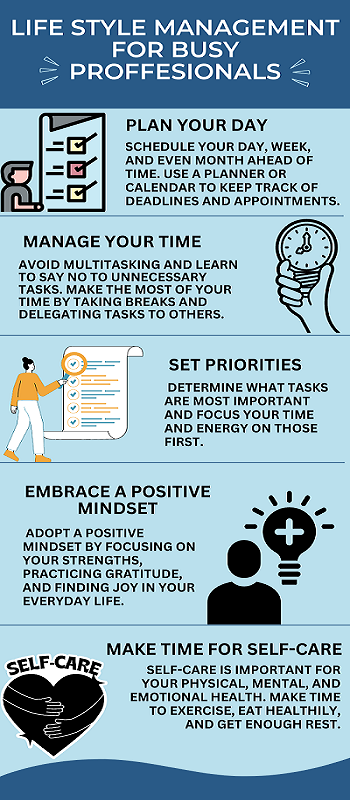As a busy professional, it can be difficult to balance work, family, and personal responsibilities. Often, the demands of work take up the majority of our time and energy, leaving little room for self-care and personal growth. However, it is important to prioritize our health and well-being, as neglecting these aspects of our lives can lead to burnout, stress, and a decreased quality of life.
Lifestyle management is the practice of taking an intentional and proactive approach to managing our daily habits and routines in a way that promotes our physical, mental, and emotional health. In this article, we will explore a complete guide to lifestyle management for busy professionals, including tips and strategies for optimizing your daily routine and creating a more fulfilling and balanced life.
- Define Your Priorities
The first step in effective lifestyle management is to define your priorities. This means taking the time to reflect on what is most important to you in life, both personally and professionally. Ask yourself questions such as:
- What are my core values?
- What are my long-term goals?
- What brings me joy and fulfillment?
- What are the non-negotiables in my life (e.g. family time, self-care, etc.)?
Once you have a clear understanding of your priorities, you can begin to structure your daily routine in a way that supports these values and goals.
- Create a Daily Schedule
Creating a daily schedule can help you stay organized and on track with your priorities. This can be especially helpful for busy professionals who have many responsibilities and commitments to balance.
Start by mapping out your day in hourly or half-hour increments. Be sure to include time for work, exercise, meals, family time, and self-care. Try to stick to your schedule as closely as possible, but also be flexible enough to adjust as needed based on unexpected events or emergencies.
- Determine your priorities: Start by identifying your top priorities for the day. What tasks or activities do you need to complete in order to achieve your goals?
- Allocate time for each task: Once you’ve identified your priorities, allocate specific blocks of time for each task. Be realistic about how long each task will take and factor in any potential interruptions or unexpected delays.
- Schedule your most important tasks first: Try to schedule your most important tasks for the times of day when you’re most productive and alert. This will help you get them done more efficiently and effectively.
- Include breaks: Make sure to schedule regular breaks throughout the day. Taking short breaks can help improve your focus and productivity.
- Consider your energy levels: Take into account your natural energy levels throughout the day. Schedule tasks that require the most mental or physical energy during the times when you’re most alert.
- Be flexible: Be prepared to adjust your schedule if necessary. Unexpected things can come up, so it’s important to be flexible and able to adapt to changes.
- Review and evaluate: At the end of each day, review your schedule and evaluate how well you followed it. This will help you make adjustments for the following day and improve your overall productivity.

- Prioritize Self-Care
If you want to keep your physical, mental, and emotional health, you need to take care of yourself. It can be easy to neglect self-care when you are busy with work and other responsibilities, but taking the time to care for yourself can actually increase your productivity and overall well-being.
Some self-care practices to consider include:
- Regular exercise or physical activity
- Mindfulness or meditation
- Quality sleep
- Healthy eating habits
- Time spent with loved ones
Make self-care a priority in your daily routine by scheduling time for these practices and committing to them as you would any other important task.
- Practice Time Management
Effective time management is key to maximizing your productivity and achieving your goals. Some tips for managing your time effectively include:
- Breaking large projects down into smaller, more manageable tasks and working on the most important ones first thing in the morning
- Limiting distractions
- Delegating tasks when possible
- Saying “no” to requests or commitments that do not align with your priorities
- Create Boundaries
Creating boundaries is essential for maintaining a healthy work-life balance. This means setting limits on your work hours, responding to emails and messages only during designated times, and saying “no” to requests or commitments that do not align with your priorities.
It can be tempting to say “yes” to everything in order to please others or advance your career, but overcommitting yourself can lead to burnout and decreased productivity in the long run. Learn to say “no” when necessary, and communicate your boundaries clearly to those around you.
- Seek Support
Managing a busy lifestyle can be challenging, but you do not have to do it alone. Seek support from friends, family, or colleagues who understand your goals and values.
- It’s okay to ask for help: Seeking support is not a sign of weakness, but rather a sign of strength. It takes courage to recognize that you need assistance and to reach out for it.
- Identify your support system: Make a list of people in your life who you trust and feel comfortable talking to. This may include family members, friends, mentors, or mental health professionals.
- Be specific about your needs: When asking for support, be clear about what you need. Whether it’s emotional support, advice, or practical help, be specific about what you’re looking for.
- Consider professional help: If you’re struggling with a mental health issue or other serious problem, seeking professional help from a therapist or counselor may be the best option.
- Be open to different types of support: There are many different types of support available, from online communities to support groups to one-on-one counseling. Explore different options and find what works best for you.
- Take care of yourself: Seeking support can be difficult and emotionally draining. Remember to take care of yourself by practicing self-care, such as getting enough sleep, eating well, and engaging in activities that bring you joy.
- Follow up: After seeking support, follow up with those who helped you and let them know how much you appreciate their support. This helps to build stronger relationships and encourages them to continue supporting you in the future.
If you’re feeling overwhelmed, stressed, or struggling with something, it’s important to seek support. Here are some tips on how to do so:
- Identify who you can turn to for support. This might be a friend, family member, therapist, or support group.
- Be honest about how you’re feeling. It’s important to communicate your thoughts and emotions openly so that those around you can understand what you’re going through.
- Ask for help. It’s okay to ask for assistance or guidance, and those around you will likely be happy to provide it.
- Take action. Once you’ve identified sources of support and asked for help, take steps to follow through on the advice or guidance you receive.
It’s important to prioritize your mental health and well-being, and seeking support is a critical step in that process.
conclusion
“The Complete Guide to Lifestyle Management for Busy Professionals” offers a comprehensive approach to managing a busy lifestyle. The guide provides practical advice on how to balance work and personal life, maintain good health, and cultivate positive habits. It emphasizes the importance of setting goals, prioritizing tasks, and delegating responsibilities to achieve a more fulfilling life.
The guide recognizes the challenges faced by busy professionals in today’s fast-paced world and provides solutions to overcome them. It offers strategies for time management, stress reduction, and self-care that are easy to implement in daily life.
Overall, “The Complete Guide to Lifestyle Management for Busy Professionals” is an invaluable resource for anyone looking to enhance their well-being and productivity. By following the tips and techniques outlined in the guide, busy professionals can create a more balanced, healthy, and fulfilling lifestyle.
Faq’s
Q: What is “The Complete Guide to Lifestyle Management for Busy Professionals?”
A: “The Complete Guide to Lifestyle Management for Busy Professionals” is a comprehensive guidebook designed to help busy professionals manage their lives more effectively by providing practical advice, strategies, and tools.
Q: What are some tips for effective time management for busy professionals?
A: Effective time management for busy professionals involves prioritizing tasks, setting realistic goals, delegating responsibilities, and minimizing distractions. It is important to establish a routine, schedule regular breaks, and avoid multitasking to increase productivity and reduce stress.
Q: How can busy professionals maintain a healthy diet?
A: Busy professionals can maintain a healthy diet by planning meals in advance, choosing nutritious foods, and avoiding fast food and processed foods. Meal prepping and bringing healthy snacks to work can also help avoid unhealthy food choices.
Q: What are some tips for staying active as a busy professional?
A: Staying active as a busy professional involves finding activities that fit into a busy schedule, such as taking a walk during lunch breaks or joining a gym near work. It is important to aim for at least 30 minutes of moderate-intensity exercise per day and to incorporate strength training and stretching into the routine. Using fitness apps and setting fitness goals can also help stay motivated.
Q: What are some tips for maintaining positive relationships as a busy professional?
A: Maintaining positive relationships as a busy professional involves making time for family and friends, setting aside time for social activities, and communicating effectively. It is important to prioritize relationships and establish healthy boundaries to prevent burnout and maintain work-life balance.















